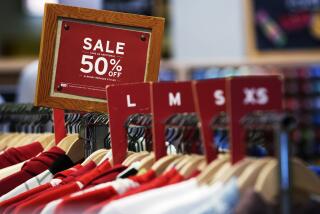Borrowing Growth Drops to 3-Year Low
- Share via
U.S. consumer borrowing grew at the slowest pace in more than three years in August as demand for credit card and auto loans stalled, according to Federal Reserve Board figures released Monday.
Americans’ consumer credit rose $3.3 billion in August to $1.167 trillion, down from July’s revised increase of $7.3 billion. Previously, the Fed said July borrowing rose $7.7 billion. Analysts had expected an August increase of $7.0 billion.
After a three-year borrowing binge that nearly doubled the borrowing total, the August slowdown suggests that “consumers’ debt burden is much too high and people can’t keep up that pace of borrowing,” said Kevin Flanagan, an economist at Dean Witter Reynolds in New York. “Consumer spending could slow accordingly.”
The borrowing slowdown may be linked to a new, cautious attitude by lenders in response to an increase in bankruptcy filings by consumers and a surge in credit card delinquencies.
“This number is telling us a lot of the delinquent consumer credit out there is starting to bite,” said Anthony Chan, chief economist at Banc One Investment Advisors Corp. in Columbus, Ohio. “We’re moving to a slightly slower growth patch in the economy.”
For retailers, the report may be a warning that consumer demand will prove disappointing for the second year in a row during the Christmas shopping season, analysts said.
Although the report is the latest indicator to suggest the economy is losing steam, some analysts say people shouldn’t read too much into one month’s report.
“Consumers are still sufficiently confident to continue purchasing on credit,” said Lynn Reaser, chief economist at Barnett Banks in Jacksonville, Fla.
Monday’s Fed report shows that credit card borrowings rose $2.8 billion in August, auto loans increased by $200 million and other types of personal loans rose by $400 billion. The Fed’s report does not track loans secured by real estate.
The report also shows that the pace of consumer credit was rising at a 3.5% annual rate during August. That’s the slowest pace since May 1993 and down from the 7.6% pace of borrowing in July.
Economists use the Fed’s consumer credit statistics to monitor the health of household finances as a way of making predictions about future consumer spending, which accounts for two-thirds of overall economic activity in the U.S.
In response to a rise in loan delinquencies earlier this year, the Federal Deposit Insurance Corp., the agency responsible for insuring Americans’ bank deposits, stepped up its monitoring of bank credit card operations.
More to Read
Inside the business of entertainment
The Wide Shot brings you news, analysis and insights on everything from streaming wars to production — and what it all means for the future.
You may occasionally receive promotional content from the Los Angeles Times.










